Puss in Boots: Full Text Story, Video in English Version, Life Lessons
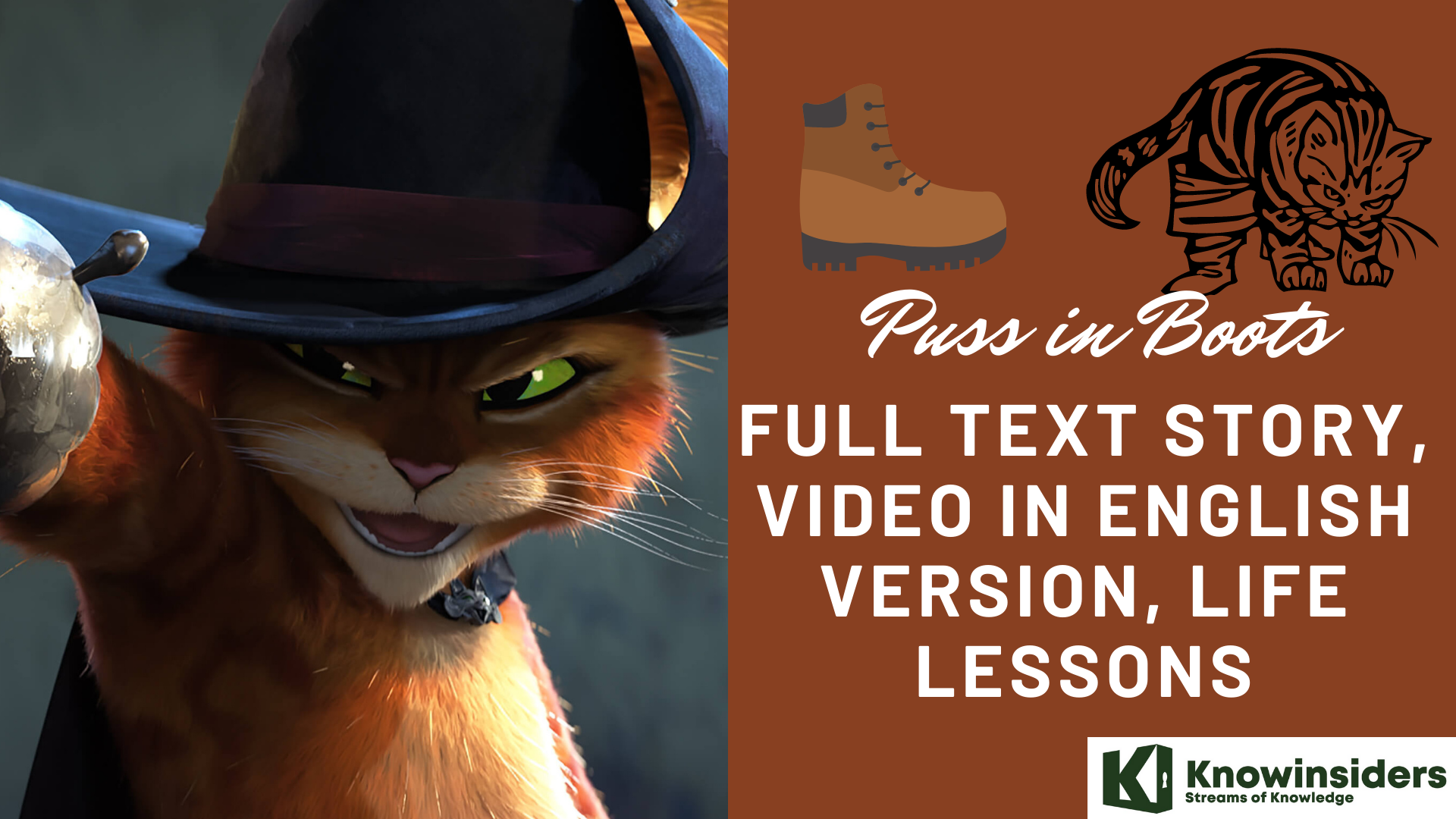 |
| Puss in Boots: Full Text Story, Video in English Version, Life Lessons |
| Table Content |
"Puss in Boots" (Italian: Il gatto con gli stivali) is an Italian fairy tale, later spread throughout the rest of Europe, about an anthropomorphic cat who uses trickery and deceit to gain power, wealth, and the hand of a princess in marriage for his penniless and low-born master.
The oldest written telling is by Italian author Giovanni Francesco Straparola, who included it in his The Facetious Nights of Straparola (c. 1550–1553) in XIV–XV. Another version was published in 1634 by Giambattista Basile with the title Cagliuso, and a tale was written in French at the close of the seventeenth century by Charles Perrault (1628–1703), a retired civil servant and member of the Académie française. There is a version written by Girolamo Morlini, from whom Straparola used various tales in The Facetious Nights of Straparola. The tale appeared in a handwritten and illustrated manuscript two years before its 1697 publication by Barbin in a collection of eight fairy tales by Perrault called Histoires ou contes du temps passé. The book was an instant success and remains popular.
"Puss in Boots" has provided inspiration for composers, choreographers, and other artists over the centuries. The cat appears in the third act pas de caractère of Tchaikovsky's ballet The Sleeping Beauty, appears in the sequels and self-titled spin-off to the animated film Shrek and is signified in the logo of Japanese anime studio Toei Animation. Puss in Boots is also a popular pantomime in the UK.
Puss In Boots: Video In English Version
The Surprising Origins of ‘Puss In Boots’
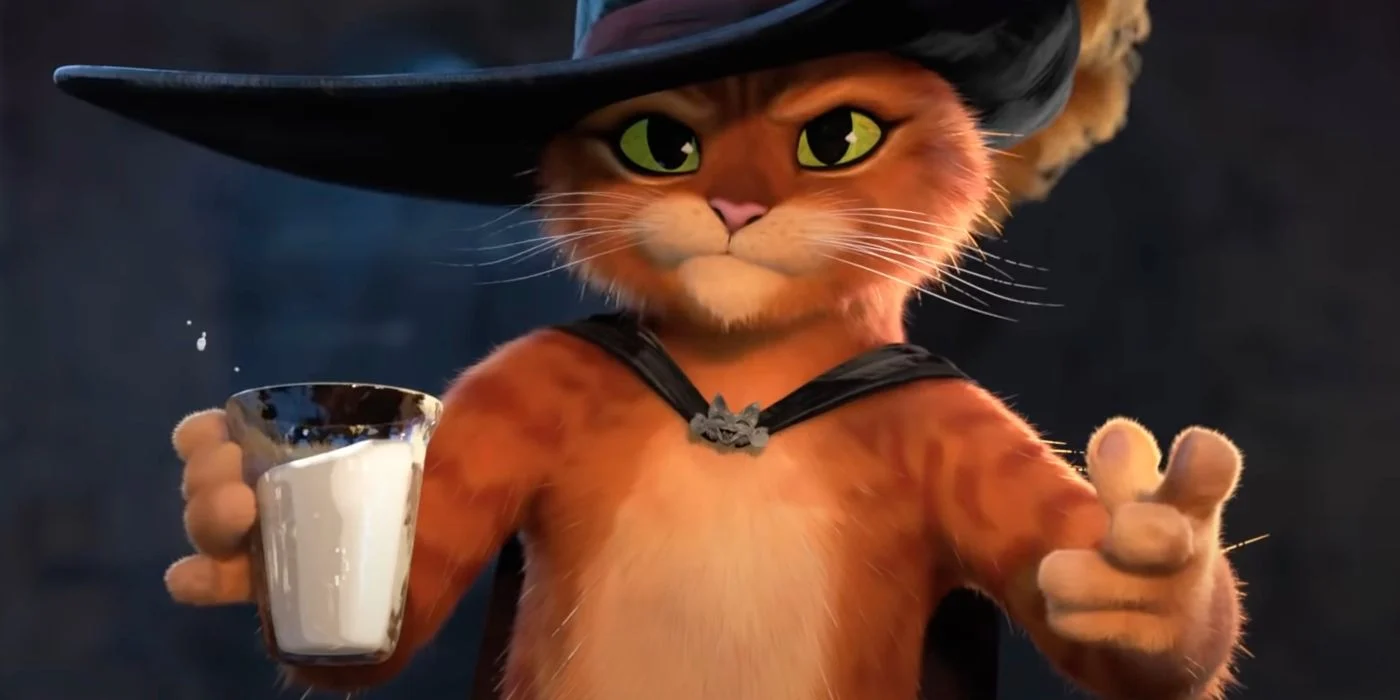 |
| Photo: DreamWorks |
Fairytales are told in almost every society, all around the world. And yet, despite their universality and ability to inspire generations young and old, they often fail to fit neatly into any one mode of storytelling.
The only unifying characteristics that fairytales have are that they are usually relatively short and feature ‘fantasy’ characters, such as dwarves, elves, fairies, giants, gnomes, goblins, mermaids, trolls or witches, and often some element of magic or enchantments. Fairytales may also be distinguished from other folk narratives such as legends and explicitly moral tales, including fables or those of a religious nature, because they don’t necessarily always have a clear lesson. The fact that their meaning is not always expressly clear or easy to pin down is part of what makes fairytales so fascinating to read together and such a valuable starting point for imagination and curiosity.
In order to get a better sense of the context from which these tales arose, we will be looking at the surprising origins of some of the most beloved fairytales in our collection—beginning with ‘Puss in Boots.’
Of the first classic fairytale collection
 |
| Photo: Getty Images |
Despite enjoying a recent increase in popularity, thanks to its inclusion in the Shrek franchise and subsequent spinoff, ‘Puss in Boots’ is actually one of the oldest fairytales of all. A classic example of the fairytale featuring the animal as a helper ‘Puss in Boots’ happened in 1697 when Charles Perrault included it in his collection of fairy stories.
Even at that point, though, the tale of a resourceful speaking cat had already been around for over a hundred and fifty years. It can originally be traced back to The Facetious Nights, a two-volume collection of 75 stories by Italian author and fairy-tale collector Giovanni Francesco Straparola, which was published in the early 1550s.
Is ‘Puss in Boots’ a trickster tale?
Although everyone can likely agree that there is something inherently intriguing about a talking cat in boots, there is less consensus when it comes to determining the story’s meaning. How we should analyse ‘Puss in Boots’ has troubled many writers and critics over the years. Although the story of ‘Puss in Boots’ contains several classic features of fairy tales, including the enterprising helper, the beautiful princess, and the ‘rags to riches’ trope of a character from humble beginnings advancing to become part of the nobility—there doesn’t seem to be a clear lesson contained in the story’s events.
In some analysis, ‘Puss in Boots’ is presented as a trickster tale since puss begins tricking those in more powerful positions and forcing those beneath him to do his bidding with bribes or menaces. However, he escapes retribution—there is no point at which his cleverness turns back against him, as is often the case with trickster tales.
‘Puss in Boots’: plot summary
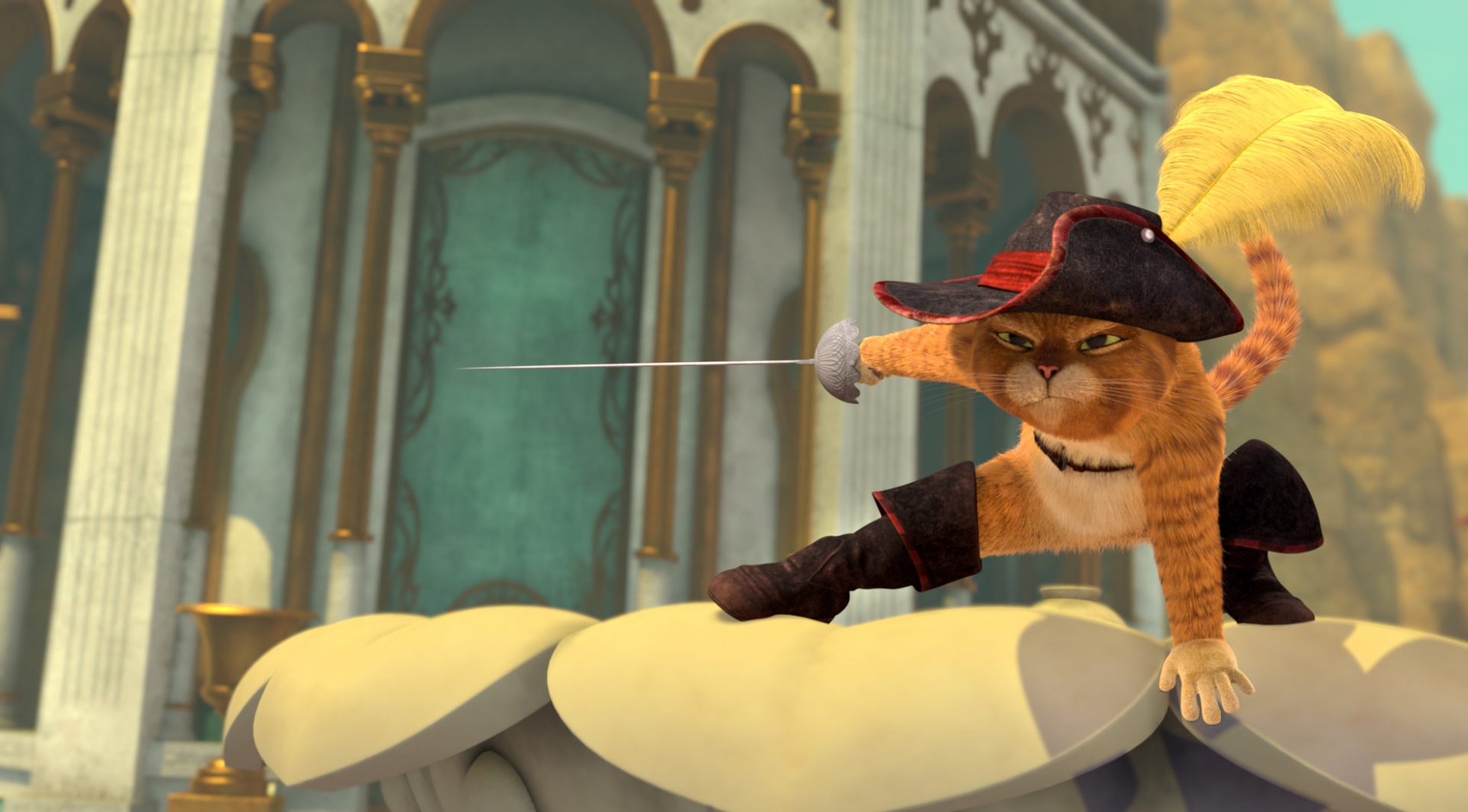 |
| Photo: DreamWorks |
Before we look more closely at this aspect of the tale, here’s a brief summary of the ‘Puss in Boots’ tale:
A miller died and left his three sons all he had: he left his mill to his eldest son, an ass to the middle son, and to the youngest son, he left his cat.
The youngest son thought he’d drawn the short straw with the cat, but the cat promised that if the son got him some boots made, he would prove to be a worthy and helpful pet. Once the cat had some boots and a little bag he could wear, he went off and hunted for rabbits. Having caught a rabbit, Puss in Boots took it to the King, telling him that it was a gift from the Lord Marquis of Carabas, the cat’s master.
Shortly after this, Puss in Boots caught some partridges, and once again he took them to the King and announced that they were a gift from the Lord Marquis of Carabas. This happened for several months.
Then, one day, Puss in Boots hatched his big plan: he commanded his master to wash at a certain point in the river, and waited until the King’s coach came riding by, with the Princess accompanying the King in the coach. Then, having concealed his master’s clothes under a rock, Puss in Boots jumped out in front of the coach and asked for help, claiming that his master, the Lord Marquis of Carabas, had been robbed, and all of his clothes had been taken.
The King, recognising the cat that had brought him so many gifts of fine food in the past, commanded the coach to stop and sent his servants to fetch some clothes for the cat’s master. The Princess, seeing the handsome ‘Lord Marquis of Carabas’ dressed in one of her father’s finest suits of clothes, was instantly smitten by him, and the King asked the Lord Marquis of Carabas to ride with them.
Puss in Boots had told the local farmers and mowers that if anybody asked them, they should reply that the land they work on belonged to the Lord Marquis of Carabas, otherwise they would be chopped up like herbs. As the King rode through the land in his coach, he stopped and spoke to some of the people working the land, and they all told him that the land belonged to the Lord Marquis of Carabas. Puss in Boots’ plan had worked.
The King’s coach approached a large castle, and Puss in Boots told him that the owner of the castle was the same person who owned all of the land they had travelled through. Travelling on ahead of the castle, Puss in Boots managed to get inside and spoke to the owner of the castle, who was an ogre. The ogre, it was said, could transform himself into many different animals, and to prove his point, promptly turned himself into a lion.
Puss in Boots was impressed (and slightly scared) by this, but as soon as the ogre had returned to his normal shape, he decided to outwit him. ‘I hear that you can also change yourself into a very small creature, such as a mouse,’ he said to the ogre. ‘But I don’t believe this is possible.’
Offended by this statement, and determined to show off his skills, the ogre transformed into a little mouse, and Puss in Boots, seizing his chance, promptly jumped on the mouse and ate him up.
When the King’s coach arrived at the castle, Puss in Boots announced that the King and all his retinue were welcome to the Castle of the Lord Marquis of Carabas. The King was impressed to learn that the cat’s master owned this vast castle as well as all of the local estates, and they went in and feasted, and the Princess, clearly in love with the cat’s master, was betrothed to the Lord Marquis of Carabas, and they were married the same day.
Puss in Boots became a lord, and they all lived happily ever after, apart from the ogre, who was dead.
‘Puss in Boots’: analysis
 |
| Puss brings presents to the King. Illustration from a 1902 Polish picture book edition of "Puss in Boots". |
The story of ‘Puss in Boots’, as this summary demonstrates, contains several classic features of fairy tales: the enterprising helper (Puss in Boots himself), the hero and the beautiful princess, and the ‘rags to riches’ story of a character from humble beginnings rising up to become part of the nobility.
The story ends with marriage and with the plucky cat being rewarded for his cleverness. We might analyse ‘Puss in Boots’ along these lines, and view it as one of a number of classic tales of social climbing – but what marks it out is the presence of the cat (though we should remember that Dick Whittington, the Lord Mayor of London in the famous pantomime, also had a cat – although there’s no evidence the real Richard Whittington ever owned a pet cat).
But what is the moral of ‘Puss in Boots’? As we’ve discussed previously in our analysis of the Goldilocks fairy tale, fairy stories often don’t appear to have clear morals. The ‘moral’ of ‘Puss in Boots’ seems to be: lie, cheat, threaten the local populace, and you will be rewarded with a lordship (not very realistic, that someone known for lying and cheating and mistreating others would be showered with honours, eh?).
On the other hand, we might view Puss in Boots as a creature who makes the best of his (and his master’s) bad lot in life: he does everything he does in order to create a better life for his luckless master (and, by extension, for himself).
But why a cat? Dogs are more celebrated for loyalty and service than cats (although, let’s face it, cats are far and away the better animal). But cats are known for hunting, and this quality comes in useful both at the beginning and the end of Puss in Boots’ plan, when he catches the rabbit and partridges, and then kills the ogre having cheated him into transforming himself into a mouse.
Perhaps ‘Puss in Boots’ is supposed to cause us unease: cats are known for their cunning, and they can be deadly hunters, but they are also useful creatures to have around.
But like a number of classic fairy tales, ‘Puss in Boots’ existed before Perrault’s famous 1697 volume brought it to a wider readership. In the 1634 Italian book Pentamerone, we find the story of a beggar’s son who inherited nothing from his father but a cat. The cat promised to make him rich, and every morning the cat went to catch fish which it took to the King of Naples, claiming they were from a mysterious benefactor named Lord Gagliuso.
Eventually, the King wanted to meet this generous Lord, so on the day on which a meeting was arranged, the cat turned up and pretended that his master had had all of his possessions stolen in the night, so he didn’t even have any clothes to wear in which to visit the King. The King sent some of his own clothes (via the cat), and the cat promptly gave them to the beggar’s son and told him to dress up in them.
The beggar’s son was wined and dined by the King, and the cat told the King that ‘Lord Gagliuso’ was so wealthy that the King would be wise to forge an alliance with his Lord. The King sent his servants out to survey Lord Gagliuso’s (supposed) estates, and the cat followed them, telling them that everywhere they went there were robbers roaming the land, and the best way to protect themselves was to report back to the King that all of the land they surveyed belonged to Lord Gagliuso.
When the King heard that Gagliuso owned such extensive lands, he suggested that his daughter marry Gagliuso, to forge an alliance. The beggar’s son was promptly married to the Princess, the cat having negotiated a large dowry from the King for the marriage – money which ‘Gagliuso’ used to buy a large estate.
Although this is the point where Perrault’s rendering of the story ends, in the Pentamerone the tale continues: the cat requests that when he dies, ‘Gagliuso’ will honour his memory by burying him in a gold coffin. The former beggar’s son promises to honour this wish, but to test him, three days later the cat pretends to be dead, and is shocked to hear his master command his wife to sling the cat out of the window.
Angered by this, the cat storms out and never returns, leaving ‘Gagliuso’ to fend for himself in future. So in the Pentamerone, there’s a twist in the tale (or the tail).
‘Puss in Boots’: Full Text Story To Read For Your Kids
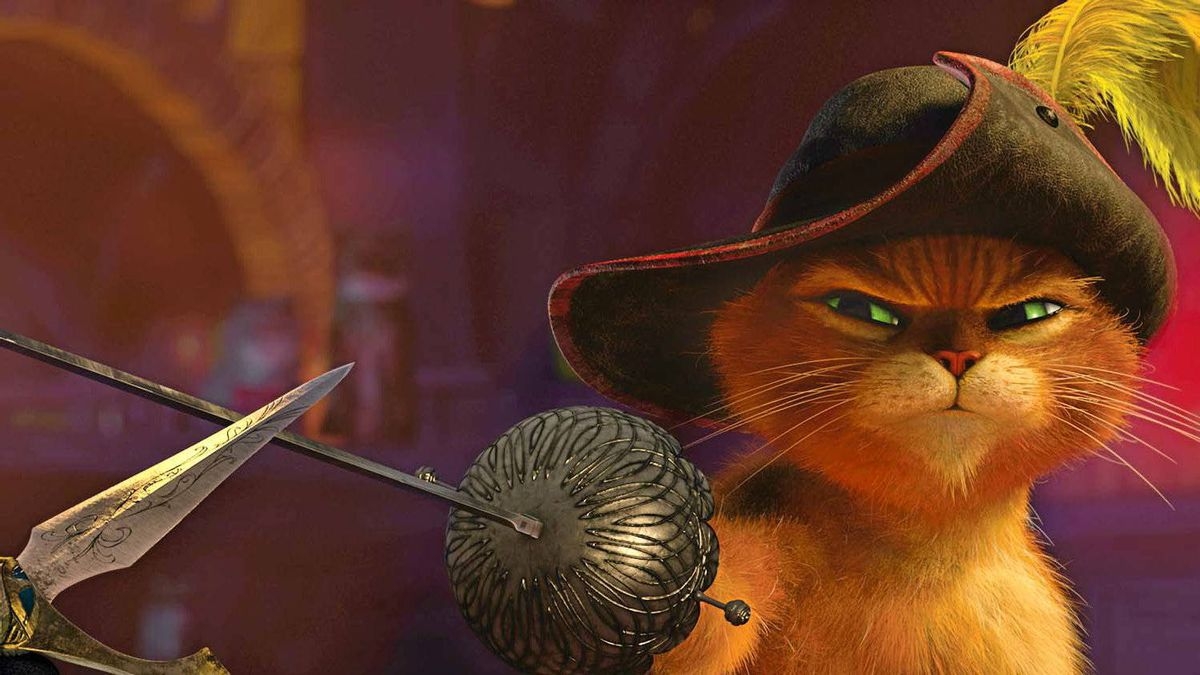 |
| Photo: DreamWorks |
There was a miller, who left no more estate to the three sons he had, than his Mill, his Ass, and his Cat. The partition was soon made. Neither the scrivener nor attorney were sent for. They would soon have eaten up all the poor patrimony. The eldest had the Mill, the second the Ass, and the youngest nothing but the Cat.
The poor young fellow was quite comfortless at having so poor a lot.
"My brothers," said he, "may get their living handsomely enough, by joining their stocks together; but for my part, when I have eaten up my Cat, and made me a muff of his skin, I must die with hunger."
The Cat, who heard all this, but made as if he did not, said to him with a grave and serious air:
"Do not thus afflict yourself, my good master; you have only to give me a bag, and get a pair of boots made for me, that I may scamper thro' the dirt and the brambles, and you shall see that you have not so bad a portion of me as you imagine."
Tho' the Cat's master did not build very much upon what he said, he had however often seen him play a great many cunning tricks to catch rats and mice; as when he used to hang by the heels, or hide himself in the meal, and make[70] as if he were dead; so that he did not altogether despair of his affording him some help in his miserable condition.
When the Cat had what he asked for, he booted himself very gallantly; and putting his bag about his neck, he held the strings of it in his two fore paws, and went into a warren where was great abundance of rabbits. He put bran and sow-thistle into his bag, and stretching himself out at length, as if he had been dead, he waited for some young rabbit, not yet acquainted with the deceits of the world, to come and rummage his bag for what he had put into it.
Scarce was he lain down, but he had what he wanted; a rash and foolish young rabbit jumped into his bag, and Monsieur Puss, immediately drawing close the strings, took and killed him without pity. Proud of his prey, he went with it to the palace, and asked to speak with his Majesty. He was shewed up stairs into the King's apartment, and, making a low reverence, said to him:
"I have brought you, sir, a rabbit of the warren which my noble lord the Marquis of Carabas" (for that was the title which Puss was pleased to give his master) "has commanded me to present to your Majesty from him."
"Tell thy master," said the King, "that I thank him, and that he does me a great deal of pleasure."
Another time he went and hid himself among some standing corn, holding still his bag open; and when a brace of partridges ran into it, he drew the strings, and so caught them both. He went and made a present of these to the[71] King, as he had done before of the rabbit which he took in the warren. The King in like manner received the partridges with great pleasure, and ordered him some money to drink.
The Cat continued for two or three months, thus to carry his Majesty, from time to time, game of his master's taking. One day in particular, when he knew for certain that the King was to take the air, along the river side, with his daughter, the most beautiful Princess in the world, he said to his master:
"If you will follow my advice, your fortune is made; you have nothing else to do, but go and wash yourself in the river, in that part I shall shew you, and leave the rest to me."
The Marquis of Carabas did what the Cat advised him to, without knowing why or wherefore.
While he was washing, the King passed by, and the Cat began to cry out, as loud as he could:
"Help, help, my lord Marquis of Carabas is drowning."
At this noise the King put his head out of his coach-window, and finding it was the Cat who had so often brought him such good game, he commanded his guards to run immediately to the assistance of his lordship the Marquis of Carabas.
While they were drawing the poor Marquis out of the river, the Cat came up to the coach, and told the King that while his master was washing, there came by some rogues, who went off with his clothes, tho' he had cried out "Thieves, thieves," several times, as loud as he could. This cunning[72] Cat had hidden them under a great stone. The King immediately commanded the officers of his wardrobe to run and fetch one of his best suits for the lord Marquis of Carabas.
The King received him with great kindness, and as the fine clothes he had given him extremely set off his good mien (for he was well made, and very handsome in his person), the King's daughter took a secret inclination to him, and the Marquis of Carabas had no sooner cast two or three respectful and somewhat tender glances, but she fell in love with him to distraction. The King would needs have him come into his coach, and take part of the airing. The Cat, quite overjoyed to see his project begin to succeed, marched on before, and meeting with some countrymen, who were mowing a meadow, he said to them:
"Good people, you who are mowing, if you do not tell the King, that the meadow you mow belongs to my lord Marquis of Carabas, you shall be chopped as small as mince-meat."
The King did not fail asking of the mowers, to whom the meadow they were mowing belonged.
"To my lord Marquis of Carabas," answered they all together; for the Cat's threats had made them terribly afraid.
"Truly a fine estate," said the King to the Marquis of Carabas.
"You see, sir," said the Marquis, "this is a meadow which never fails to yield a plentiful harvest every year."
The Master Cat, who still went on before, met with some reapers, and said to them:
"Good people, you who are reaping, if you do not tell the King that all this corn belongs to the Marquis of Carabas, you shall be chopped as small as mince-meat."
The King, who passed by a moment after, would needs know to whom all that corn, which he then saw, did belong. "To my lord Marquis of Carabas," replied the reapers; and the King again congratulated the Marquis.
The Master Cat, who went always before, said the same words to all he met; and the King was astonished at the vast estates of my lord Marquis of Carabas.
Monsieur Puss came at last to a stately castle, the master of which was an Ogre, the richest had ever been known; for all the lands which the King had then gone over belonged to this castle. The Cat, who had taken care to inform himself who this Ogre was, and what he could do, asked to speak with him, saying, he could not pass so near his castle, without having the honour of paying his respects to him.
The Ogre received him as civilly as an Ogre could do, and made him sit down.
"I have been assured," said the Cat, "that you have the gift of being able to change yourself into all sorts of creatures you have a mind to; you can, for example, transform yourself into a lion, or elephant, and the like."
"This is true," answered the Ogre very briskly, "and to convince you, you shall see me now become a lion."
Puss was so sadly terrified at the sight of a lion so near him, that he immediately got into the gutter, not without abundance of trouble and danger, because of his boots, which were ill-suited for walking upon the tiles. A little while after, when Puss saw that the Ogre had resumed his natural form, he came down, and owned he had been very much frightened.
"I have been moreover informed," said the Cat, "but I know not how to believe it, that you have also the power to take on you the shape of the smallest animals; for example, to change yourself into a rat or a mouse; but I must own to you, I take this to be impossible."
"Impossible?" cried the Ogre, "you shall see that presently," and at the same time changed into a mouse, and began to run about the floor.
Puss no sooner perceived this, but he fell upon him, and ate him up.
Meanwhile the King, who saw, as he passed, this fine castle of the Ogre's, had a mind to go into it. Puss, who heard the noise of his Majesty's coach running over the drawbridge, ran out and said to the King:
"Your Majesty is welcome to this castle of my lord Marquis of Carabas."
"What! my lord Marquis?" cried the King, "and does this castle also belong to you? There can be nothing finer than this court, and all the stately buildings which surround it; let us go into it, if you please."
The Marquis gave his hand to the Princess, and followed the King, who went up first. They passed into a spacious hall, where they found a magnificent collation which the Ogre had prepared for his friends, who were that very day to visit him, but dared not to enter knowing the King was there. His Majesty was perfectly charmed with the good qualities of my lord Marquis of Carabas, as was his daughter who was fallen violently in love with him; and seeing the vast estate he possessed, said to him, after having drank five or six glasses:
"It will be owing to yourself only, my lord Marquis, if you are not my son-in-law."
The Marquis making several low bows, accepted the honour which his Majesty conferred upon him, and forthwith, that very same day, married the Princess.
Puss became a great lord, and never ran after mice any more, but only for his diversion.
How should we interpret the story?So if puss never has to answer for his misdeeds, what (if any) is the moral of the story? As mentioned above, one of the differentiating aspects of fairytales from fables or religious stories is that there is often no clear moral, leaving the tale more open to interpretation. Although one could plausibly argue that the ‘moral’ of ‘Puss in Boots’ seems to be that it pays off to lie, cheat, threaten—that’s only one way to look at it. On the other hand, we could view puss as a creature who makes the best of his (and his master’s) lousy lot in life. He is simply doing everything in his power to improve the situation of his disenfranchised master. The story is written explicitly to allow the reader to take their own lessons from the story – for example that knowledge, and being quick thinking can help you succeed in life. What about the boots?Although the morality of ‘Puss in Boots’ may not be easy to pin down, it does include revealing socio-historical cues that can be interesting to note from a modern perspective. The fact that the Puss has boots, for example, should not be overlooked. When the story was written, attaining a pair of shoes was an essential step in climbing the social ladder. Children outgrew shoes so quickly that they were a luxury afforded only to young persons of the very upper class. Therefore, getting a pair of shoes marked a critical time in a person’s life when they were growing up and filling a role in society. If an adult did not manage to get a pair of shoes, though, they might be looked down on as a result. And the fact that a cat got an audience with the king simply for being well dressed and having boots, shows how much appearances and presentation mattered. We tend to think that our society is overly focused on appearances now, but ‘Puss in Boots’ tells us something about the role they have always played. The story illustrates that society’s standards for appearance have always played a very important role in people’s lives. And even though you should not judge a book by its cover, people will still judge you based on your looks and actions – a point well-worth discussing with your child as you read. |
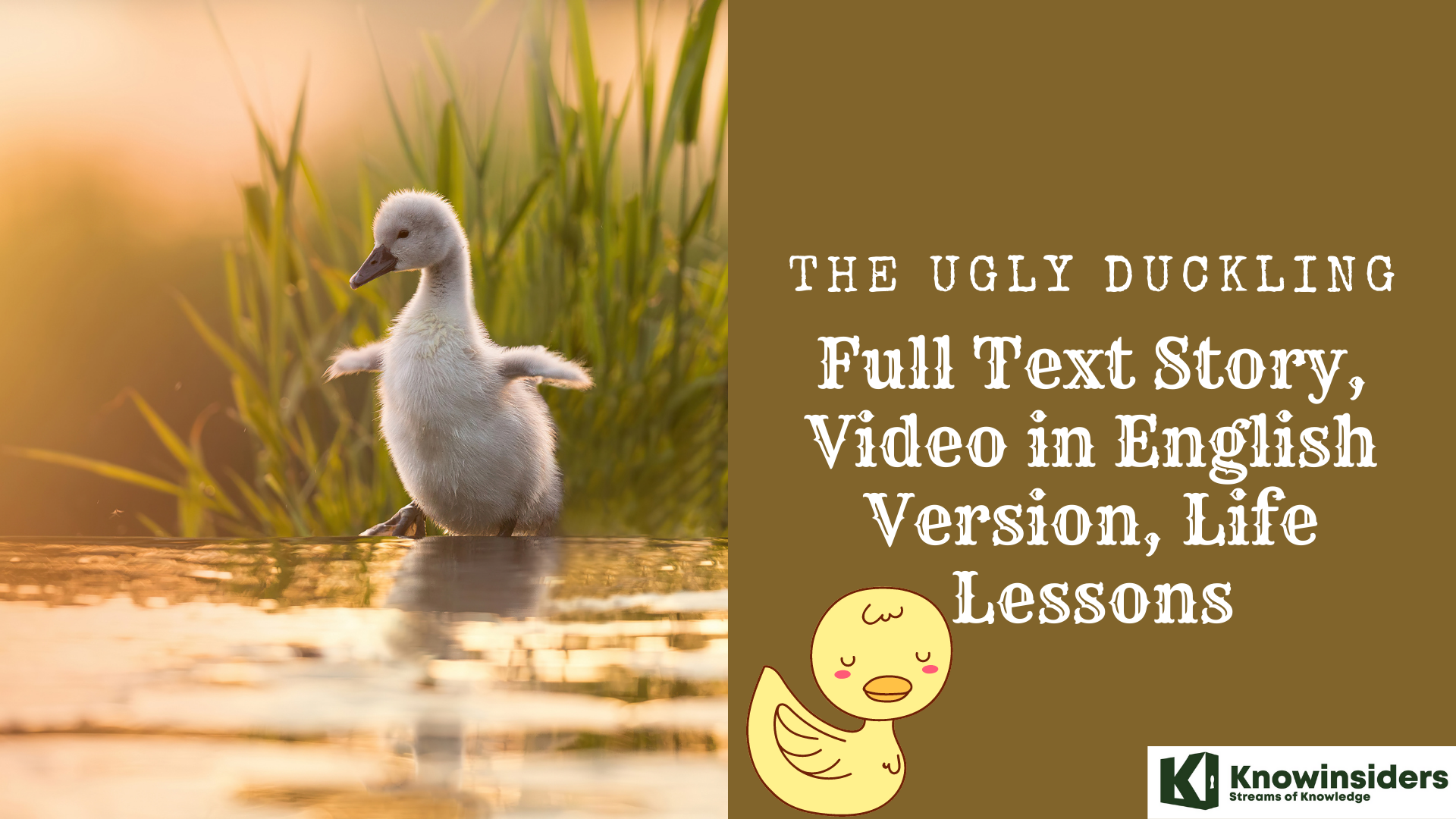 The Ugly Duckling: Full Text Story, Video in English Version, Life Lessons The Ugly Duckling: Full Text Story, Video in English Version, Life Lessons Reading or watching the best fairy tale of The Ugly Duckling: Here are the full-text story, beautiful pictures, and the best video in the English ... |
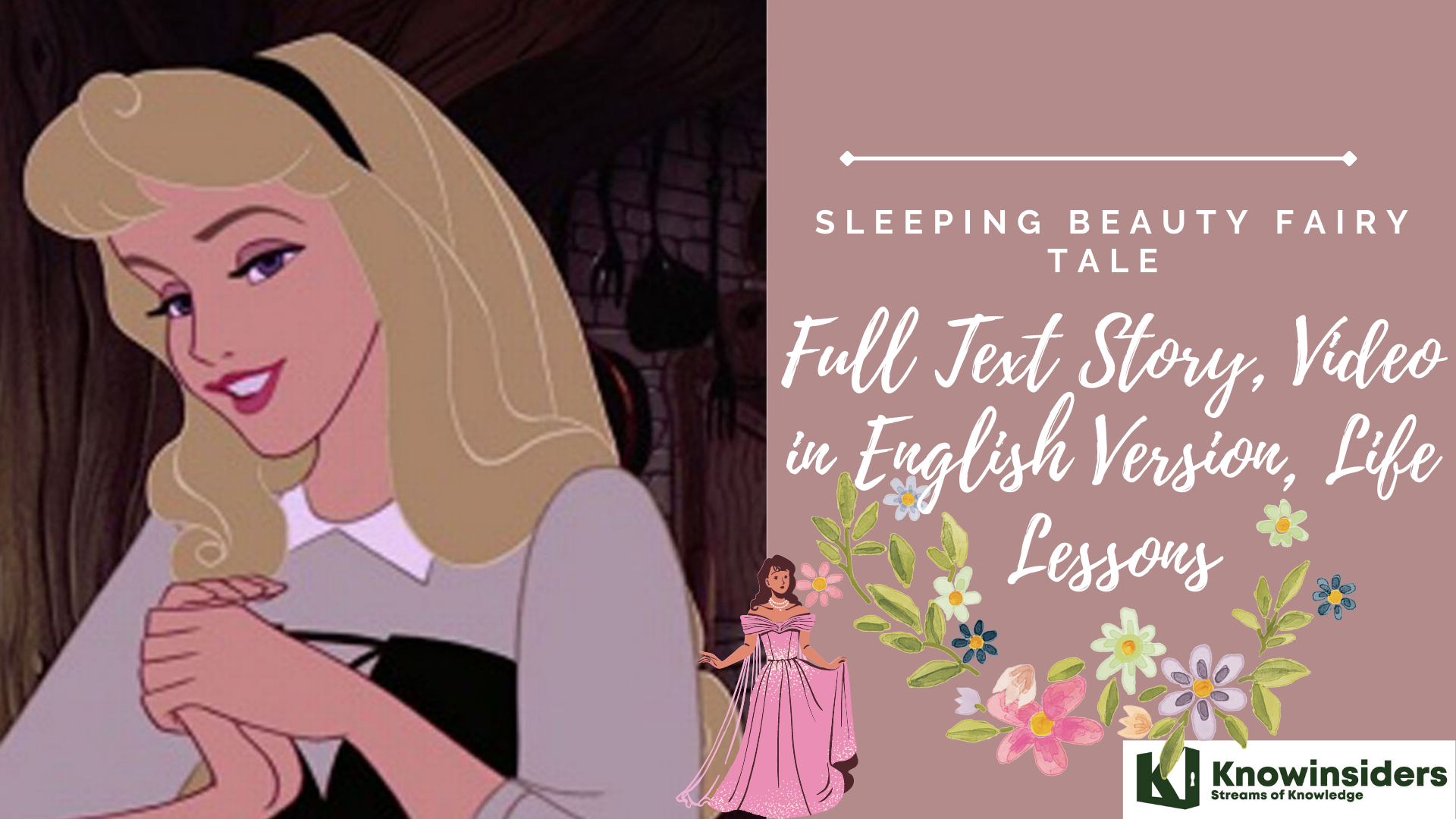 Sleeping Beauty: Full Text Story, Video in English Version, Life Lessons Sleeping Beauty: Full Text Story, Video in English Version, Life Lessons Reading or watching the best fairy tale of Sleeping Beauty: Here are the full-text story, beautiful pictures, and the best video in the English version. |
 Jack and the Beanstalk: Full Text Story, Video in English Version, Life Lessons Jack and the Beanstalk: Full Text Story, Video in English Version, Life Lessons Reading or watching the best fairy tale of Jack and the Beanstalk: Here are the full-text story, beautiful pictures, and the best video in the ... |
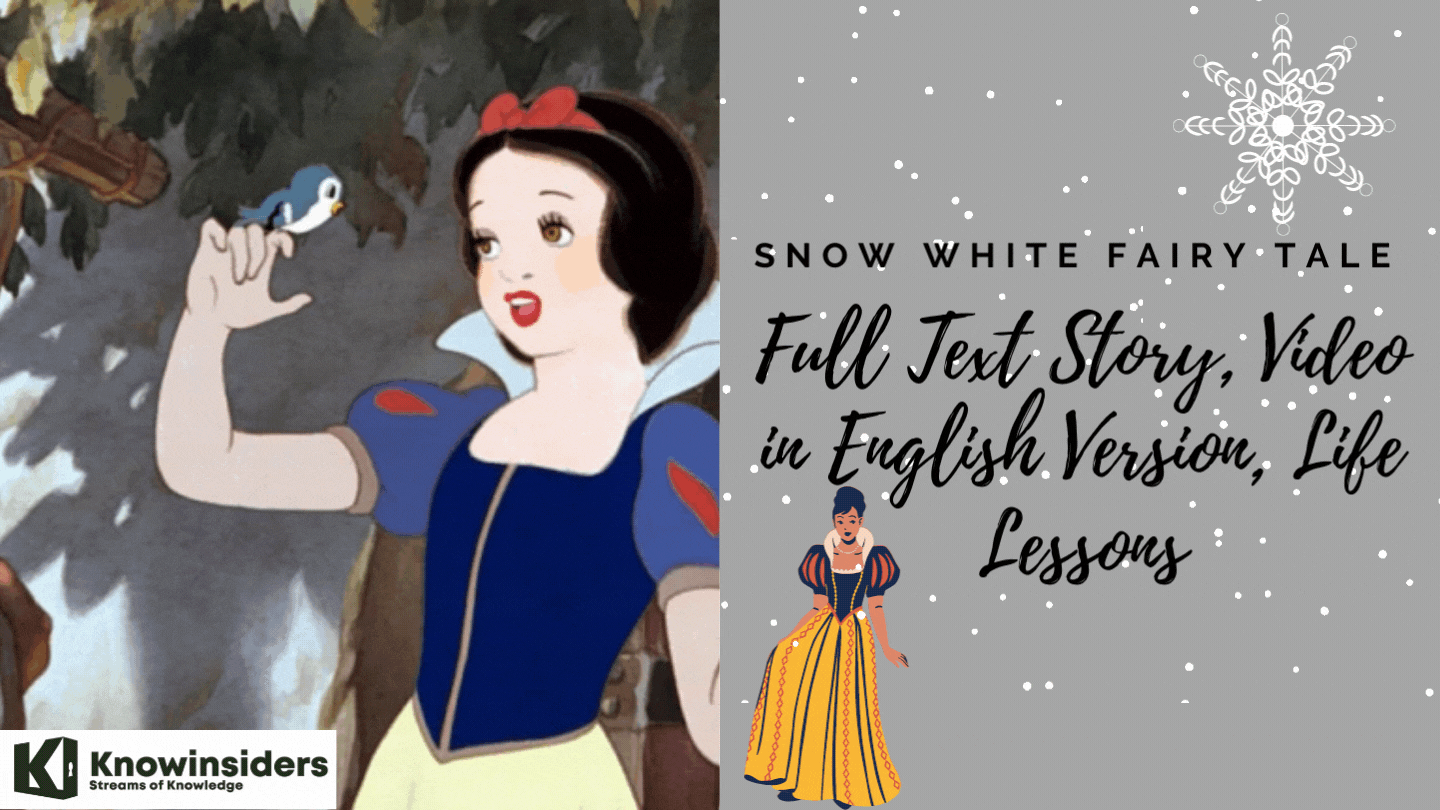 Snow White and the Seven Dwarfs: Full Text Story, Video in English Version, Life Lessons Snow White and the Seven Dwarfs: Full Text Story, Video in English Version, Life Lessons Reading or watching the best fairy tale of Snow White and the Seven Dwarfs: Here are the full-text story, beautiful pictures, and the best video ... |


























